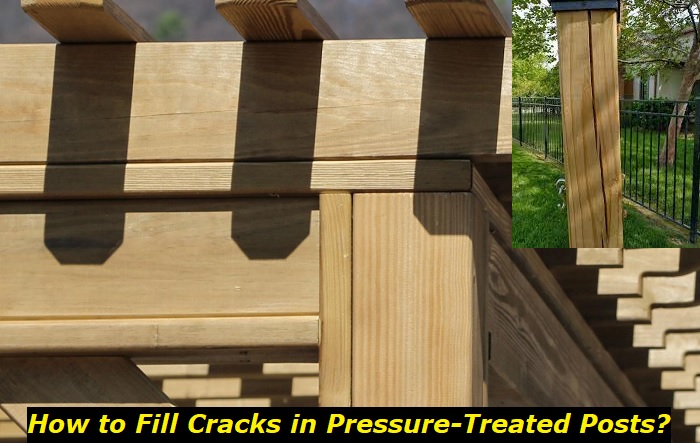You have just finished building the new wooden deck outside your home and looking forward to sitting out on it, enjoying the sunshine with a cold drink in your hand. Giving it the once over a few days later, you notice that a crack has developed in one of the posts.
You were so careful when drilling and inserting the bolts and finishing off the structure. How could this have happened? And now what are you going to do? You cannot replace the post, and how long will it last with that crack in it? The good news is that there are ways to fix it.

What Caused It
Before repairing, it is important to understand what caused it in the first place. Provided it was not due to an existing crack in the wood or caused by a construction error, it could be due to moisture or age and is completely natural.
When lumber is out in the open and not treated with a water-repellent, the transfer of moisture between the wood and the environment can cause stress on the wood from the constant wetting and drying of the surface or shrinkage as the post ages.
Check or Crack
In woodworking terms, a split in wood is termed either a check or a crack. A check is when the split occurs vertically or with the grain of the pole. This is a more natural occurrence, whereas a crack is a horizontal split, against the grain, and is caused by excessive weight on the pole. The process to repair both is the same.
6 Important Things to Know About Pressure-Treated Posts
- They have been chemically treated against insects and rot.
- They are not suitable for all woodworking projects.
- There are 3 types:- alkaline copper quaternary, borate, and non-combustible.
- They contain a lot of water and, therefore are difficult to paint.
- They may last up to 40 years.
- The chemicals are safe but wear face protection including a mask when cutting, drilling, or sanding them.
Should You Repair It?
There are two schools of thought when it comes to repairing pressure-treated wooden posts. Some say that they have already been treated with anti-splitting chemicals and you should not try and repair them, especially with external wood filler.
When the filler starts to dry out, it will crack, chip, and fall out. Cracks don’t seem to weaken the strength of the post. If you don’t like the aesthetics of the crack or are dubious about the strength and longevity of the post, there are ways of repairing it, at least on a semi-permanent basis.
What You Will Need to Repair It
- powdered waterproof glue or epoxy resin depending on the size of the crack. If the crack is very small, a syringe is useful to fill it with glue.
- water
- paint brush
- clamps
- screwdriver or pry bar.
- scrap wood or sawdust of the same type as the post or similar.
- band saw
- hammer
- scraper or sandpaper
- wood stain (optional)
- waterproof wood finisher
Instructions
- Mix the glue with the water or prepare the epoxy resin as per the instructions on the packet. Add the wood stain if required.
- Pry the split open with enough force to create an opening without damaging the wood further and clean out any dust or other particles.
- Paint the glue onto the insides of the split and around the opening with enough glue to completely coat the surfaces until the glue starts to run out of the bottom of the split.
- Check and apply glue to any additional splits around the pole and if the main split runs to the other side.
- Clamp the post tightly not more than an inch or two apart between the clamps. If the split runs through on both sides, alternate the clamps.
- If the cracks are large and wide open, cut different-sized wedges of scrap wood using the band saw and hammer them into any splits that are not filled with glue and clamp shut. For smaller cracks, a mixture of glue and sawdust may do the trick. Allow the glue to dry overnight.
- The following day, remove the clamps and scrape off excess glue and protruding wood scraps with a scraper, chisel, or sandpaper.
- Paint with a couple of coats of a weatherproof wood finisher.
Preventing Splits
This article would be amiss if some advice on preventing poles from splitting in the first place was not given. That being said, there is no foolproof way of preventing splits or checks. Ensuring you treat your wooden structure regularly with wood stain and/or waterproof sealant or paint, may prolong the life of the wood.
Cedar can be treated immediately, but pine may need 2 to 6 months of drying out before treatment, depending on your climate. This is especially important if you live in an area with very cold winter temperatures. Paint the whole structure with an all-weather product to lessen the chance of freezing temperatures stressing the wood.
Final Thoughts
Pressure-treated posts are normally treated with chemicals to prevent damage by insects or rot. Cracks or checks in the wood that run with the grain are naturally caused by age, drying out and temperature and moisture changes in the environment. Checks do not normally compromise the strength and integrity of the post.
There are ways, however, to fix cracks, at least on a semi-permanent basis. To try and prevent or keep your posts as healthy as possible once repairs have been done, it is wise to treat them with an all-weather wood finisher occasionally.
- Can You Unmix Paint: Techniques, Consequences, Alternatives - February 23, 2024
- Does Primer Need to be Mixed? Effective Primer Application - February 22, 2024
- How to Make Old Paint Usable Again: Retrieving and Preserving Paint - February 21, 2024



